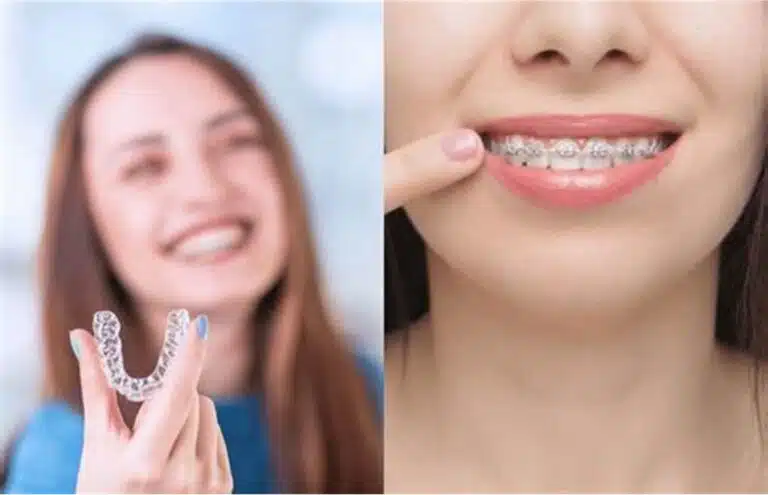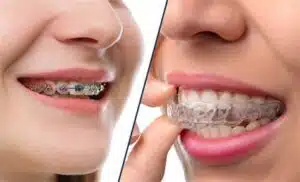For teenagers with orthodontic needs, how braces feel matters just as much as how they work. Both treatment options can effectively straighten teeth, but they offer distinctly different experiences for teens navigating the already challenging adolescent years. Understanding the comfort differences between Metal Braces vs. Clear Aligners can help your teen make a choice they’ll be happy with throughout their orthodontic journey.
Physical Comfort: The Daily Experience
When it comes to orthodontic treatment, physical comfort is one of the most important considerations for teens. The day-to-day experience of wearing braces or aligners can significantly impact a teenager’s quality of life, affecting everything from eating and speaking to participating in daily activities. Let’s examine how metal braces and clear aligners compare in terms of physical comfort during everyday wear.
Metal Braces
Metal braces have been the standard orthodontic treatment for decades, but they can present some physical discomfort challenges for teens. Traditional braces feature metal brackets attached to teeth, connected by wires that apply pressure to move teeth into proper alignment.
With metal braces, there’s a risk of developing irritation on the inner surfaces of lips and cheeks. The metal brackets and wires can sometimes rub against soft tissue, though orthodontic wax can be applied to brackets to reduce this irritation. Regular adjustment appointments also help manage ongoing discomfort.
Traditional metal braces are made of high-quality stainless steel, making them solid and durable for treating various dental problems. While they can initially cause some discomfort and make oral hygiene more challenging, specially designed tools like interdental brushes, floss threaders, and water flossers can help teens maintain good oral health with proper instruction and routine.
Clear Aligners
Clear aligners offer a different physical experience for teens compared to traditional braces.
Made of smooth plastic material, clear aligners are generally comfortable to wear. Research shows that teens may experience similar discomfort to braces during the initial days after switching to a new tray. However, this discomfort typically disappears within a few days as the mouth adjusts to the new aligner.
Clear aligners typically apply gentler pressure to teeth than braces, which many teens find more manageable throughout treatment. While the smooth construction generally prevents irritation to the tongue and inner lips, some teens may occasionally report sharp edges or need to file down rough spots on new aligners.
Lifestyle Compatibility for Active Teens
The orthodontic treatment option you choose can have a major impact on your teen’s daily activities and lifestyle. For teenagers juggling school, sports, social activities, and possibly even part-time jobs, the compatibility of their orthodontic treatment with their busy lifestyle is crucial. Different treatment options offer varying degrees of flexibility and convenience that can either enhance or restrict a teen’s ability to participate fully in their regular activities.
Removability Factor
One of the most significant differences between Metal Braces vs. Clear Aligners is whether they can be removed during treatment.
Metal braces are fixed by the orthodontist and remain in place until the end of treatment. In contrast, clear aligners can be easily removed by the patient for eating, drinking, brushing, and flossing. This removability gives teens more control over their oral hygiene and eating experience.
Sports and Activities
For active teenagers, orthodontic treatment choice can impact their participation in sports and other activities.
Both treatment options can be made safe for sports participation with the right gear. For braces wearers, specialized orthodontic mouthguards are designed to fit over brackets and provide protection during contact sports. With clear aligners, teens should remove their aligners before putting in a standard sports mouthguard. Always store aligners in their protective case during sports activities.
Appearance and Social Comfort
For many teens, the visible appearance of their orthodontic treatment is a concern during these socially sensitive years.
Clear aligners offer a less visible alternative to traditional metal braces. The transparent design allows teens to straighten their teeth without the noticeable appearance of metal brackets and wires.
Traditional braces, while effective, are more visible during social interactions, school photos, and special events. The visual difference between Metal Braces vs. Clear Aligners is one of the most important factors teens consider when choosing an orthodontic treatment option.
Oral Hygiene and Maintenance
Maintaining good oral hygiene during orthodontic treatment is crucial but presents different challenges depending on the treatment choice.
Metal Braces Challenges
Dental hygiene during orthodontic treatment with braces is more complex. Patients must dedicate more time and detail to eliminate visible residues, and despite these efforts, this is sometimes difficult to achieve. Additionally, oral hygiene during braces treatment requires using specific utensils to reach food particles stuck in intricate spaces between teeth, wires, and between crooked teeth in the process of alignment.
Clear Aligner Advantages
With aligners, taking care of teeth is more straightforward. Teens can simply remove their aligners whenever they need to brush or floss, then brush normally. Additionally, teens can eat anything they crave; they just remove the aligners for any food or beverage other than water. Cleaning the aligners themselves is relatively simple, often requiring only a gentle brush with mild soap and rinsing with water.
Treatment Effectiveness and Duration
While comfort is a primary concern, effectiveness also matters to teens who want their treatment completed as quickly as possible.
The treatment time for each option depends on the complexity of the case. Both metal braces and clear aligners have proven effective for straightening teeth, though each may be better suited to different orthodontic situations.
Metal braces may be recommended for more complex cases, while clear aligners often work well for mild to moderate alignment issues. Your orthodontist can provide specific treatment timelines based on your teen’s unique dental needs.
Responsibility and Compliance
Clear aligners require commitment and self-discipline from teens to ensure successful treatment.
These appliances must be worn for at least 22 hours daily to be effective. This means teens must develop the discipline to wear their aligners diligently, only removing them at appropriate times.
For parents concerned about compliance, many aligner systems now offer wear indicators and smartphone apps to help teens track their daily usage. Some orthodontists recommend involving parents in the monitoring process during the first few weeks until proper habits are established.
Making the Right Choice for Your Teen
When deciding between metal braces and clear aligners for your teen, consider these key factors:
Both solutions are effective for correcting orthodontic conditions and giving your child a beautiful, healthy smile.
If your teenager doesn’t have severely crooked or twisted teeth and their bite isn’t severely misaligned, clear aligners may be an excellent choice. However, if your teen has extremely crooked teeth or a significant bite issue, traditional braces may provide better results.
Consider your child’s preferences and comfort level. You want them to feel motivated during treatment so they can achieve their dream smile while learning responsibility along the way.
Conclusion
When weighing Metal Braces vs. Clear Aligners for teens, comfort considerations extend beyond just physical sensation. Social comfort, lifestyle compatibility, hygiene maintenance, and treatment effectiveness all play important roles in the overall experience.
Clear aligners generally offer greater physical comfort with their smooth surfaces and removability, while also providing social benefits through their nearly invisible appearance. However, they require more responsibility from teens to ensure consistent wear and proper care.
Metal braces, while less comfortable physically and more visible, offer reliable results without concerns about compliance, potentially better outcomes for complex cases, and may be more cost-effective for some families.
The best choice depends on your teen’s specific orthodontic needs, lifestyle, and personal responsibility level. Consulting with an orthodontist who can evaluate these factors will help determine which method will provide the most comfortable and effective treatment experience for your teenager.
Ready to Explore Orthodontic Options for Your Teen?
Your teenager’s comfort during orthodontic treatment directly impacts their confidence and daily life. The right solution can make all the difference between a stressful experience and a smooth journey to a beautiful smile.
Visit Holt Orthodontics to learn more about teen-friendly orthodontic approaches and schedule a consultation to discuss which solution would be most appropriate and comfortable for your teenager.



